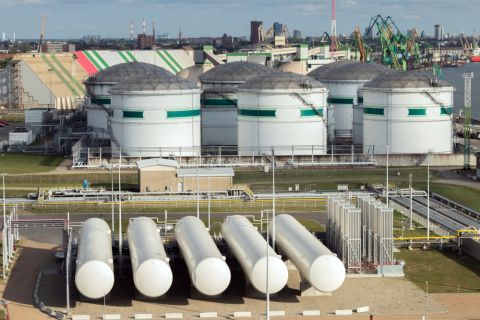 |
| The 11 blocks on offer in Uruguay’s First Offshore Bid Round are located in the Punta del Este and Pelotas Basins, and the Oriental del Plata further offshore. (Image courtesy of Uruguay’s ANCAP) |
In South America, between Argentina and Brazil, Uruguay presents itself as an enjoyable pacific country with a generally mild and stable climate. The country has a high standard of living and smooth geography featuring a variety of landscapes. Currently, Uruguay is considered to be one of the safest countries in the world, and it stands out due to its national concern for the environment.
The good news about Uruguay is that its economy has experienced a sharp growth in the last several years, which is supported both by a favorable external context and dynamic domestic activity. Investments in the country increased throughout the 1990s, and its direct foreign investments reached their highest levels in the country’s history.
The government of Uruguay took measures to solidify continued foreign investments last year. As a result, new regulations were passed aimed at offering tax incentives to companies carrying out projects within the country.
As part of its attempt to diversify foreign investments, the country’s national oil company, ANCAP, is promoting Uruguay’s first offshore licensing round. The round was officially kicked off in December 2008 and is being promoted with a series of road shows with more to be announced through to the July 1, 2009, deadline.
The 11 blocks on offer are in the Punta del Este and Pelotas Basins, and the Oriental del Plata further offshore. Available blocks range from 965 to 3,861 sq miles (2,500 to 10,000 sq km) in size. Water depths range from 164 to 4,922 ft (50 to 1,500 m).
ANCAP’s technicians used a series of 2-D seismic data acquired by Wavefield Inseis ASA to establish a number of bright spots and possible plays in the region. Uruguay’s government announced earlier this year that it had identified more than a dozen prospective offshore natural gas areas, each of which could boast 1 to 3 Tcf of gas, although a spokesman for ANCAP cautioned that it would be very premature to estimate reserves.
At present, no companies are working in Uruguay’s upstream oil and gas sector, but two small companies (one from US and one from Australia) have applied to get an onshore prospection license, ANCAP’s spokesman said. To date, there are no producing fields in the country.
The fiscal setting for the country’s bid round is encouraging. Although mining rights are not conceded through the country’s investments promotion regime, licenses will be awarded on a production-sharing agreement only with the contractor paying according to agreed upon percentages. Potential bidders in the round will not be required to pay signature bonuses, royalties, or taxes. Bidders will be responsible for social security fees.
The participation of the State, the portion of the production used to recover costs and investments, and the profits the company intends to retain for itself will have to be provided in the bids. ANCAP will evaluate these proposals with the corresponding exploratory program offered.
ANCAP has held road shows in Asia, Europe, and the Americas to increase interest in the round. Some majors have already purchased seismic data on the blocks including Hess, CNPC of China, Devon, and Repsol YPF. The Uruguayan company plans to hold additional rounds each year, but does not plan to compete for blocks in future auctions.
Currently, Uruguay’s natural gas market is quite small, but the country is connected to Argentina’s gas market. With no production to date, Uruguay hopes to use its current bid round to diminish the level of imported hydrocarbons to achieve some form of energy sovereignty.
Bids for the round are due July 1, 2009. For more information on the country’s available acreage visit www.rondauruguay.gub.uy or email info@rondauruguay.gub.uy for specific details on the upcoming round.
Recommended Reading
Diamondback’s Van’t Hof Plays Coy on Potential Delaware Divestiture
2024-05-16 - Diamondback Energy’s President and CFO Kaes Van't Hof also addressed new Permian exploration and the lack of “fun” dealing with the FTC on its deal to buy Endeavor Energy Resources.
Minerals Market Growing But Needs More Scale, Consolidation
2024-05-15 - The market value of public minerals and royalties companies has doubled since 2019—but the sector needs to grow even larger to attract generalist investors into the fray, experts say.
Marketed: Berlin Resources Anadarko Basin Opportunity
2024-05-13 - Berlin Resources LLC has retained EnergyNet for the sale of an Anadarko Basin opportunity in the Donita 35/2 AP #1H in Roger Mills County, Oklahoma.
TotalEnergies, Sinopec to Develop SAF Unit in China
2024-03-26 - TotalEnergies and Sinopec’s production unit will have the capacity to produce 230,000 tons of sustainable aviation fuel per year.
‘Unexpected’ JV to Move Permian NatGas to Gulf Coast LNG Terminals
2024-03-26 - A trio of midstream companies—Enbridge, Whitewater and MPLX—will work together to build infrastructure to transport Permian Basin natural gas to Gulf Coast LNG terminals.




